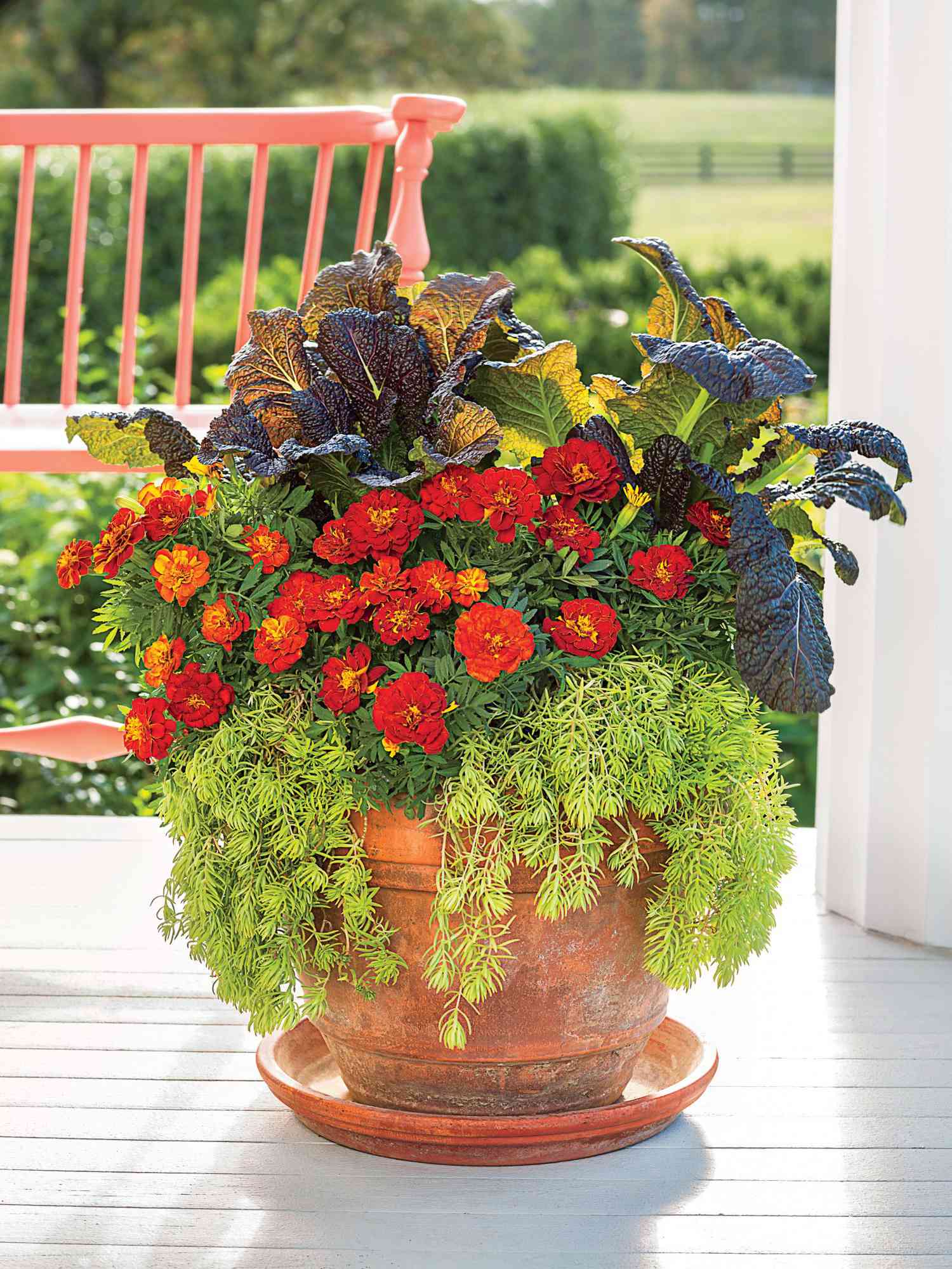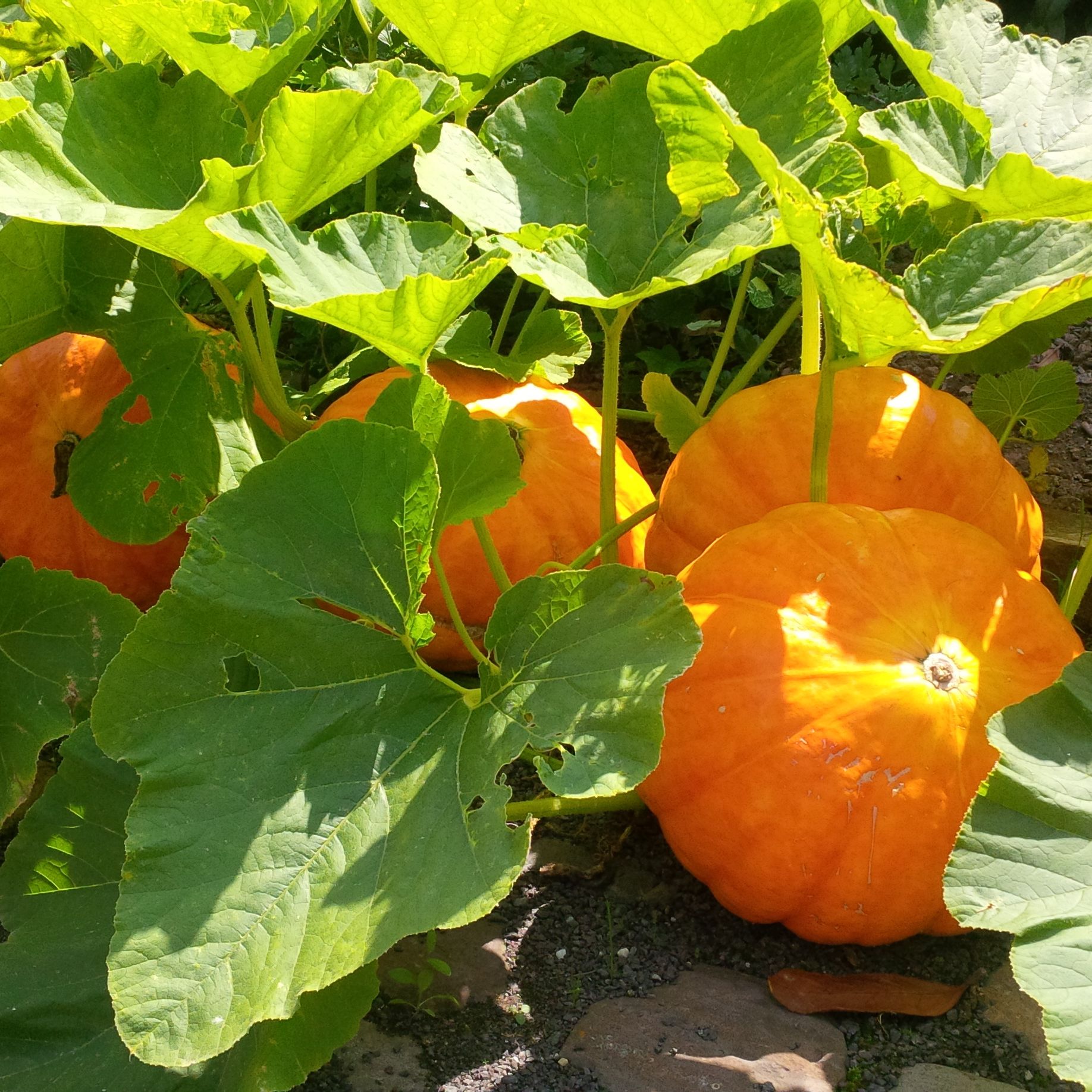Imagine transforming your balcony or patio into a stunning floral oasis this fall. With a wide array of vibrant and resilient flowers to choose from, you can create a container garden that will bring a burst of color to your outdoor space. Whether you’re a seasoned gardener or just starting out, this article will guide you through the best fall flowers for pots and container gardens, helping you create a captivating display that will brighten up your autumn days. From mums to pansies, we’ll explore the top picks that will not only survive but thrive in cooler temperatures, allowing you to enjoy the beauty of nature right at your fingertips. So grab your gardening gloves and get ready to embark on a blooming adventure!
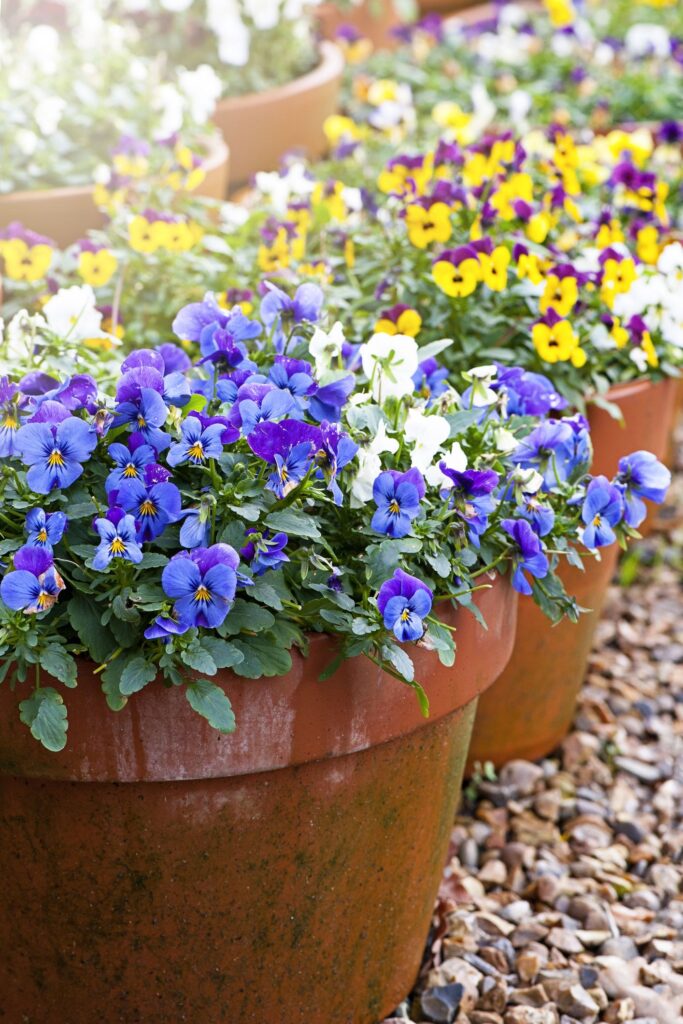
This image is property of hips.hearstapps.com.
1. Chrysanthemums
1.1 Types of Chrysanthemums
Chrysanthemums, or “mums” as they are commonly known, are a popular choice for fall gardens. They come in a variety of colors, sizes, and petal shapes, making them a versatile and stunning addition to any container garden. Some common types of chrysanthemums include the spider mum, daisy mum, cushion mum, and pompon mum. Each variety has its own unique characteristics, with some having long, slender petals while others have short, compact blooms. By choosing different types of chrysanthemums, you can create a visually interesting and vibrant display in your fall container garden.
1.2 How to Grow Chrysanthemums in Pots
Growing chrysanthemums in pots is relatively easy, and it allows you to enjoy their beauty even if you have limited garden space. To start, you’ll need a well-draining potting mix and a container that is at least 12 inches wide and deep. Chrysanthemums prefer full sun, so choose a location for your pots that receives at least 6-8 hours of direct sunlight each day. When planting your chrysanthemums, be sure to space them about 12-24 inches apart to allow for adequate air circulation. Water your potted chrysanthemums regularly, keeping the soil evenly moist but not soggy.
1.3 Care Tips for Chrysanthemums
To keep your chrysanthemums looking their best throughout the fall season, it’s important to provide them with proper care. Regularly deadhead spent blooms to encourage more flowers to form, and pinch back the tips of the plants in early summer to promote bushier growth. Water your chrysanthemums deeply and evenly, taking care not to water the leaves to avoid fungal diseases. Additionally, it’s a good idea to feed your chrysanthemums with a balanced fertilizer every few weeks to ensure they receive the necessary nutrients for healthy growth.
1.4 Popular Varieties of Chrysanthemums
There are many popular varieties of chrysanthemums to choose from, each offering its own unique beauty. Some popular varieties include the ‘Fireworks’ chrysanthemum, which has long, curved petals that resemble fireworks bursting in the sky. The ‘Spider Chrysanthemum’ is another eye-catching variety, with its long, thin petals that give it a spidery appearance. For a more traditional look, the ‘Daisy Chrysanthemum’ is a classic choice. It features large, flat flowers with a central disk surrounded by delicate petals. Lastly, the ‘Pompon Chrysanthemum’ is a small, compact variety with tightly packed petals that resemble fluffy pompoms. With so many options to choose from, you’re sure to find a chrysanthemum variety that suits your personal taste and complements your fall container garden beautifully.
2. Pansies
2.1 Why Pansies Are Great for Fall
Pansies are a popular choice for fall gardens due to their vibrant colors and ability to thrive in cooler temperatures. These cheerful flowers come in a wide range of colors, including shades of purple, yellow, orange, and white, allowing you to create stunning visual displays in your containers. Pansies also have a long blooming period, providing color and beauty throughout the fall season. Additionally, pansies are relatively low-maintenance, making them a perfect choice for both experienced gardeners and beginners alike.
2.2 Planting Pansies in Containers
When planting pansies in containers, it’s important to choose a well-draining potting mix to prevent waterlogged roots. Select a container that is at least 6-8 inches deep to allow for proper root growth. Pansies prefer full sun to partial shade, so place your pots in an area that receives at least 4-6 hours of direct sunlight each day. Space the pansies about 6-8 inches apart to give them enough room to grow and spread. Water your pansies regularly, keeping the soil moist but not overly wet.
2.3 Watering and Fertilizing Pansies
Proper watering is crucial for the health and vitality of your pansies. These flowers prefer evenly moist soil, so check the moisture level regularly and water as needed. It’s important to avoid overwatering as it can lead to root rot and other plant diseases. Additionally, pansies benefit from regular fertilization. Use a balanced, water-soluble fertilizer every 3-4 weeks to provide the necessary nutrients for optimal growth and blooming.
2.4 Best Pansy Varieties for Containers
There are many pansy varieties that are well-suited for container gardening. Some popular choices include the ‘Delta Pure Orange’ pansy, which boasts vivid orange blooms that are sure to brighten up any fall container display. The ‘Matrix Yellow Blotch’ pansy is another stunning variety, featuring sunny yellow flowers with contrasting dark centers. For those looking for a more subtle and sophisticated option, the ‘Cool Wave Blueberry Swirl’ pansy is an excellent choice. This variety produces cascading branches of blue and white blooms, creating a beautiful trailing effect in containers. With their wide array of colors and patterns, pansies offer endless possibilities for creating stunning fall container gardens.
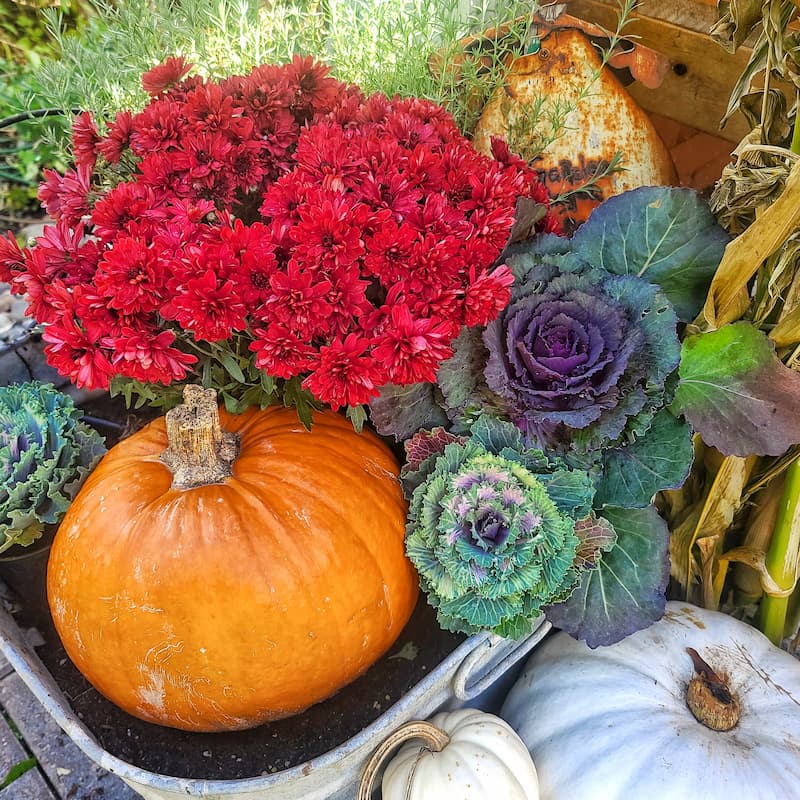
This image is property of shiplapandshells.com.
3. Ornamental Cabbage and Kale
3.1 The Beauty of Ornamental Cabbage and Kale
Ornamental cabbage and kale are not only edible but also add a unique and striking element to fall container gardens. These plants feature large, colorful leaves with ruffled edges, creating a visually interesting display. The foliage of ornamental cabbage and kale comes in a range of shades, including deep purples, vibrant pinks, and creamy whites, allowing you to create eye-catching combinations in your containers. Whether used as a focal point or as a filler plant, ornamental cabbage and kale can add texture and depth to your fall garden.
3.2 Growing Ornamental Cabbage and Kale in Pots
Growing ornamental cabbage and kale in pots is relatively simple and can be done by gardeners of all skill levels. Choose a container that is at least 12-18 inches wide to accommodate the size of the plants. Ornamental cabbage and kale prefer full sun, so place your pots in a location that receives 6-8 hours of direct sunlight each day. When planting, ensure that the soil is well-draining to prevent waterlogged roots. Plant the ornamental cabbage and kale with enough space between them to allow air circulation and prevent overcrowding.
3.3 Care and Maintenance Tips for Ornamental Cabbage and Kale
To keep your ornamental cabbage and kale looking their best, it’s important to provide them with proper care. These plants prefer moist soil, so water them regularly to keep the soil evenly moist but not waterlogged. During periods of drought, it’s especially important to monitor the moisture levels and water accordingly. Ornamental cabbage and kale are relatively low-maintenance, requiring minimal pruning or deadheading. However, removing any damaged or yellowing leaves can help promote healthy growth and overall appearance.
3.4 Recommended Ornamental Cabbage and Kale Varieties
There are several popular varieties of ornamental cabbage and kale to consider for your fall container gardens. The ‘Osaka White’ ornamental cabbage is a stunning choice, with its large, bluish-green leaves that have frilled edges and a creamy white center. For a more vibrant option, the ‘Glamour Red’ variety features deep purple leaves with intense red veins, creating a dramatic effect in any container. Another striking choice is the ‘Peacock Red’ kale, which has a feathery texture and leaves that transition from green to deep burgundy. These varieties, along with many others, offer a wide range of colors and textures to add beauty and interest to your fall containers.
4. Ornamental Peppers
4.1 Unique Features of Ornamental Peppers
Ornamental peppers are a perfect addition to fall container gardens, thanks to their colorful and eye-catching fruits. These peppers come in a variety of shapes, sizes, and colors, ranging from fiery reds and oranges to vibrant yellows and purples. They are not only ornamental but also edible, providing a unique opportunity to add a touch of spice and flavor to your fall dishes. With their vibrant fruits and attractive foliage, ornamental peppers create a bold and visually appealing statement in any container garden.
4.2 Container Requirements for Ornamental Peppers
When growing ornamental peppers in containers, it’s important to choose the right size pot and provide the necessary conditions for optimal growth. Select a container that is at least 10-12 inches wide and deep to accommodate the root system of the plants. Ornamental peppers prefer full sun, so place your pots in an area that receives at least 6-8 hours of direct sunlight each day. The soil should be well-draining to prevent waterlogged roots. As the peppers grow, you may need to provide support in the form of stakes or tomato cages to prevent the plants from bending or breaking under the weight of the fruits.
4.3 Watering and Pest Control for Ornamental Peppers
Proper watering is crucial for the health and productivity of ornamental pepper plants. These plants prefer evenly moist soil, so water them regularly, keeping the soil moist but not excessively wet. However, be careful not to overwater as it can lead to root rot. Ornamental peppers are also susceptible to common garden pests such as aphids and whiteflies. Regularly inspect your plants for any signs of pest infestation and take appropriate measures, such as using insecticidal soap or introducing beneficial insects, to control the population.
4.4 Popular Ornamental Pepper Cultivars
There are many popular cultivars of ornamental peppers to choose from, each offering its own unique color and shape. The ‘Black Pearl’ ornamental pepper is a popular choice, with its glossy black fruits that turn fiery red at maturity. For a more vibrant and playful display, the ‘Big Bomb’ pepper features large, round fruits in shades of purple, yellow, and red. Another striking variety is the ‘Explosive Ember’ pepper, which has elongated fruits that start purple and transition to deep red. These are just a few examples of the wide range of ornamental pepper cultivars available, ensuring that you can find the perfect variety to suit your fall container garden.
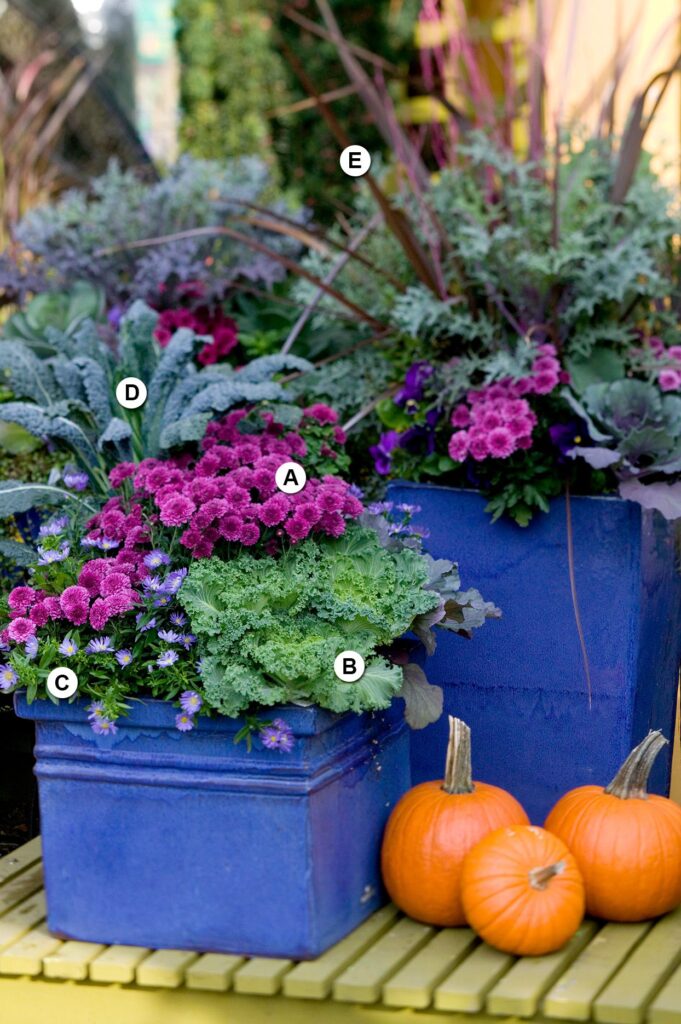
This image is property of www.bhg.com.
5. Asters
5.1 Why Asters are Perfect for Fall Gardens
Asters are a classic choice for fall gardens, thanks to their beautiful daisy-like blooms that come in an array of colors, including shades of blue, purple, pink, and white. These flowers add a charming and nostalgic touch to any container garden, and their blooms attract butterflies and other pollinators, making them an excellent choice for gardeners interested in supporting local wildlife. With their late-season bloom time, asters provide a burst of color and beauty just when summer flowers may be fading, creating a vibrant and visually appealing display.
5.2 Planting Asters in Containers
When planting asters in containers, it’s important to provide them with the right growing conditions to ensure their success. Choose a pot that is at least 12 inches wide and deep to allow for proper root growth. Asters prefer full sun to partial shade, so place your pots in an area that receives at least 4-6 hours of direct sunlight each day. The soil should be well-draining and fertile to promote healthy growth. When planting, space the asters about 12-18 inches apart to allow for adequate air circulation.
5.3 Sun and Water Requirements for Asters
Asters thrive in full sun to partial shade, so it’s important to choose a location for your containers that provides the right amount of sunlight. If your asters are not receiving enough sun, they may become leggy or fail to bloom. As for watering, asters prefer moist but not waterlogged soil. Water them regularly, keeping the soil evenly moist throughout the growing season. Additionally, be sure to provide adequate drainage to avoid root rot and other harmful conditions.
5.4 Top Asters for Container Gardens
There are numerous asters to choose from when planning your fall container garden. The ‘Purple Dome’ aster is a popular choice, with its compact growth habit and abundant purple flowers. The ‘October Skies’ aster is another stunning variety, featuring lavender-blue flowers that provide a beautiful contrast to other fall blooms. For a more unique and eye-catching option, the ‘Harrington’s Pink’ aster displays delicate pink flowers with yellow centers, creating a soft and romantic touch. These are just a few examples of the many asters available, each offering its own unique beauty and charm to enhance your fall container garden.
6. Violas
6.1 Advantages of Growing Violas in Containers
Violas are an excellent choice for fall container gardens, thanks to their vibrant colors, compact size, and cold hardiness. These cheerful flowers come in shades of purple, yellow, white, and blue, allowing you to create visually stunning displays. Unlike pansies, which are their close relatives, violas have smaller flowers and more delicate foliage, making them a perfect choice for containers where space may be limited. Violas are also known for their ability to tolerate cold temperatures, making them a reliable and long-lasting option for fall gardens.
6.2 Planting and Caring for Violas
When planting violas in containers, choose a well-draining potting mix and a container that is at least 6-8 inches deep. Violas prefer full sun to partial shade, so place your pots in a location that receives at least 4-6 hours of direct sunlight each day. Space the violas about 6-8 inches apart to allow for proper growth and airflow. Water your violas regularly, keeping the soil evenly moist. However, be careful not to overwater as it can lead to root rot. Deadhead spent blooms regularly to promote continuous flowering and remove any damaged or yellowing foliage to keep the plants looking their best.
6.3 Tips for Maximizing Viola Blooms in Fall
To maximize the blooming potential of your violas in the fall, there are a few tips to keep in mind. Firstly, ensure that your violas are receiving adequate sunlight. While they can tolerate some shade, providing them with at least 4-6 hours of direct sunlight each day will result in more abundant blooms. Secondly, regular deadheading is essential. Violas produce more flowers when old blooms are removed, so be sure to remove faded flowers regularly. Lastly, fertilize your violas every 4-6 weeks with a balanced fertilizer to provide them with the necessary nutrients for healthy growth and blooming.
6.4 Recommended Viola Varieties for Pots and Containers
There are numerous viola varieties to choose from, each offering its own unique color and charm. The ‘Sorbet Coconut Duet’ viola is a stunning choice, with its white, fringed petals that have a delicate purple edge. For a more vibrant option, the ‘ColorMax Blueberry Swirl’ viola features deep purple petals with a light blue and white center, creating a striking contrast. Another popular variety is the ‘Penny Primrose Jump Up’ viola, which boasts buttery yellow petals with deep purple veins, creating a cheerful and playful display. These are just a few examples of the many viola varieties available, each adding beauty and charm to your fall container gardens.
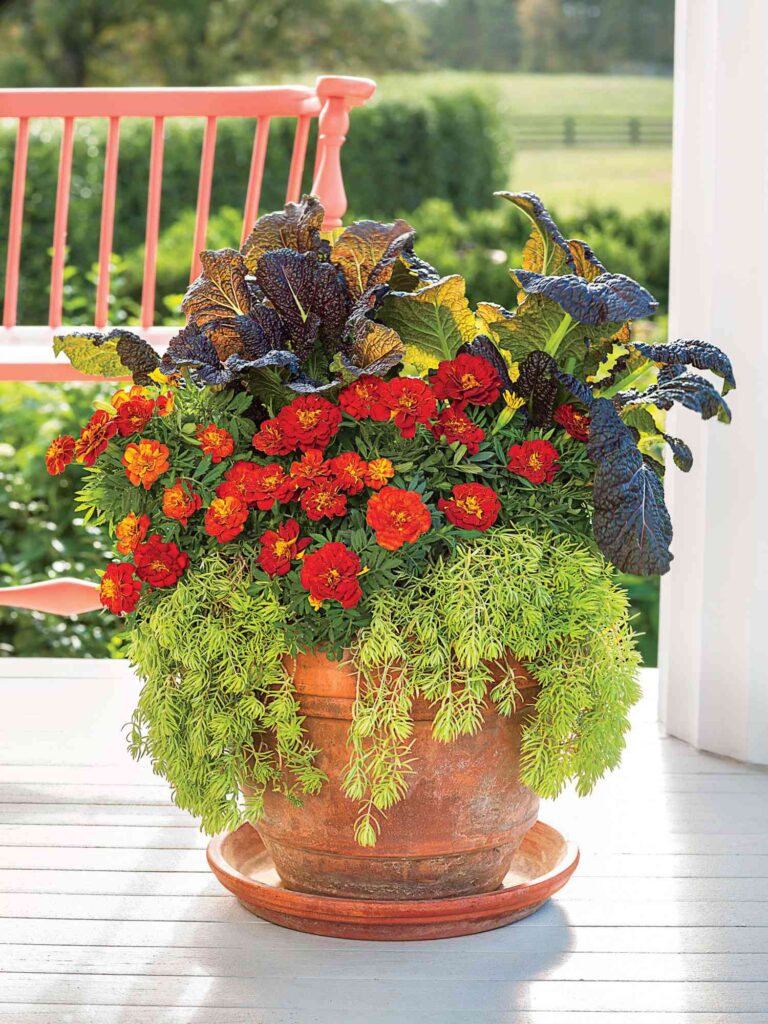
This image is property of www.southernliving.com.
7. Sedums
7.1 Benefits of Growing Sedums in Containers
Sedums, also known as stonecrops, are a versatile and low-maintenance choice for fall container gardens. These succulent plants come in a variety of shapes, sizes, and colors, making them a visually interesting addition to any container display. Sedums have thick, fleshy leaves that can withstand periods of drought, making them ideal for gardeners who may not have the time or ability to water their containers regularly. Additionally, sedums are known for their ability to attract butterflies and other pollinators, adding an ecological element to your fall garden.
7.2 Choosing an Appropriate Sedum Variety for Containers
When choosing a sedum variety for your fall container garden, consider both the size of the container and the growth habit of the sedum. Compact sedums, such as the ‘Dragon’s Blood’ sedum or the ‘Blue Spruce’ sedum, are excellent choices for containers, as their small size allows them to fit comfortably without overcrowding. Taller sedums, such as the ‘Autumn Joy’ sedum or the ‘Matrona’ sedum, can also be grown in containers, but they may require staking or a larger pot to accommodate their size. Consider the overall look and theme of your container garden when selecting a sedum variety, as different sedums offer varying colors and textures, ranging from deep greens to vibrant reds and purples.
7.3 Proper Care and Maintenance of Sedums
Caring for sedums in containers is relatively easy, as they require minimal maintenance compared to many other plants. Sedums prefer well-draining soil, so choose a potting mix specifically formulated for succulents or mix your own using equal parts potting soil, coarse sand, and perlite. These plants require full sun to partial shade, so place your containers in an area that receives at least 6-8 hours of direct sunlight each day. Water sedums sparingly, allowing the soil to dry out between each watering to prevent root rot. During periods of extreme heat and drought, it may be necessary to water more frequently. Lastly, sedums are relatively pest-free, but keep an eye out for any signs of aphids or mealybugs and take appropriate measures to control their population if necessary.
7.4 Creative Uses of Sedums in Fall Container Gardens
Sedums offer endless possibilities when it comes to creative uses in fall container gardens. Their unique growth habit and variety of colors lend themselves to various design styles and themes. Consider planting a grouping of different sedum varieties in a shallow container for a “living carpet” effect. Combine sedums with other fall favorites, such as ornamental grasses or chrysanthemums, for a dynamic and textural display. For a more minimalist approach, plant a single sedum variety in a sleek and modern container for a clean and contemporary look. Ultimately, the possibilities are limited only by your imagination, so don’t be afraid to experiment and have fun with different combinations and arrangements.
8. Calendulas
8.1 How Calendulas Enhance Fall Container Gardens
Calendulas, also known as pot marigolds, are a vibrant and versatile addition to fall container gardens. These cheerful flowers come in a range of warm hues, including shades of orange, yellow, and gold, adding a pop of color to your containers. Calendulas have a long blooming period, starting in early fall and continuing until the first frost, making them a reliable and long-lasting choice for your fall garden. Additionally, calendulas are known for their ability to attract beneficial insects such as bees and butterflies, making them an excellent addition to any pollinator-friendly garden.
8.2 Planting Calendulas in Pots and Containers
When planting calendulas in pots and containers, choose a well-draining potting mix and a container that is at least 8-10 inches deep. Calendulas prefer full sun to partial shade, so place your pots in an area that receives at least 4-6 hours of direct sunlight each day. If you live in a region with hot summers, providing some afternoon shade may be beneficial to prevent the plants from becoming heat-stressed. When spacing the plants, allow for adequate airflow and growth by placing them about 6-12 inches apart. Water your calendulas regularly, keeping the soil evenly moist but not waterlogged.
8.3 Watering and Sunlight Requirements for Calendulas
Proper watering and sunlight are crucial for the health and blooming of calendulas in containers. These plants prefer evenly moist soil, so water them regularly, allowing the soil to dry out slightly between each watering. However, be cautious not to overwater as it can lead to root rot and other fungal diseases. Calendulas thrive in full sun to partial shade, so ensure that your containers are placed in an area that receives the appropriate amount of sunlight. If the plants are not receiving enough sun, they may become leggy or fail to produce abundant blooms.
8.4 Recommended Calendula Cultivars for Containers
There are numerous calendula cultivars to choose from, each offering its own unique color and charm to enhance your fall container gardens. The ‘Indian Prince’ calendula is a popular choice, with its vibrant orange flowers and dark centers. For a more subdued and sophisticated look, the ‘Snow Princess’ calendula displays soft, creamy white flowers with delicate yellow centers. Another stunning variety is the ‘Zeolights’ calendula, which features bright yellow and light orange petals with striking dark red streaks. These, along with many other calendula cultivars, offer a wide range of colors and patterns to suit any container garden design.
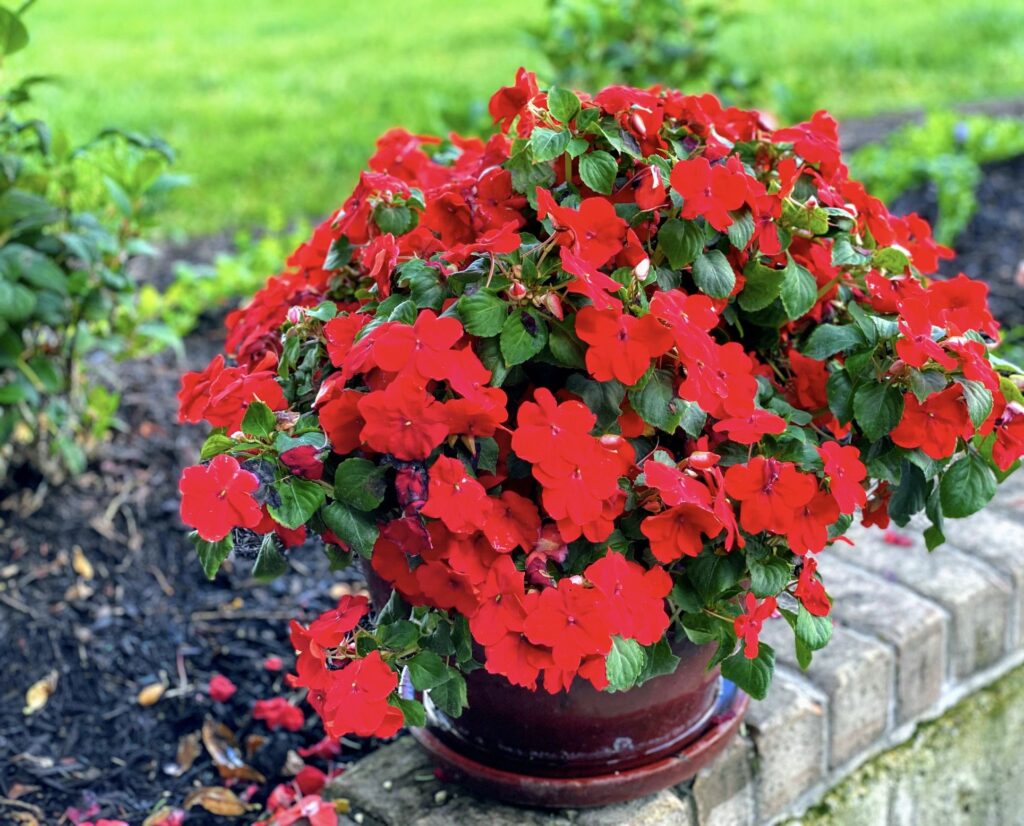
This image is property of hips.hearstapps.com.
9. Snapdragons
9.1 Snapdragons: A Fall Favorite
Snapdragons are a beloved fall flower, known for their vibrant colors and unique, bicolored blooms. These flowers come in a variety of shades, including red, pink, purple, yellow, and white, allowing for endless combinations and possibilities in your fall container gardens. Snapdragons also have a distinctive shape, with their tubular flowers resembling the snout of a dragon, earning them their whimsical name. With their tall, upright growth habit, snapdragons provide both height and vertical interest in any container display.
9.2 Growing Snapdragons in Containers
Growing snapdragons in containers is both easy and rewarding. Choose a container that is at least 12-15 inches deep to accommodate the tall growth of the plants. Snapdragons prefer full sun to partial shade, so place your pots in an area that receives at least 4-6 hours of direct sunlight each day. The soil should be well-draining and enriched with organic matter to promote healthy growth. When planting, space the snapdragons about 8-12 inches apart to allow for proper growth and airflow. Water your snapdragons regularly, ensuring that the soil remains evenly moist but not waterlogged.
9.3 Pruning and Deadheading Snapdragons
Regular pruning and deadheading are important practices for maintaining the beauty and health of snapdragons. Pruning can help promote bushier growth and prevent the plants from becoming leggy. Pinch back the main stems when the plants are about 6-8 inches tall to encourage side branching and compact growth. Additionally, removing spent blooms, or deadheading, is essential for continuous flowering. Snapdragons produce more flowers when old blooms are removed, so be sure to deadhead regularly to promote ongoing blooming throughout the fall season.
9.4 Best Snapdragons for Container Gardens
When selecting snapdragon varieties for your container gardens, consider both the height of the plant and the color of the flowers. Some popular choices for containers include the ‘Rocket’ snapdragon series, which features tall plants with dense flower spikes in a wide range of colors. The ‘Liberty’ snapdragon series is another excellent choice, with its dwarf growth habit and sturdy stems that resist lodging. For a more unique and eye-catching option, the ‘Candy Showers’ snapdragon offers delicate, trailing flowers that spill over the sides of containers, creating a beautiful cascading effect. These, along with many other snapdragon varieties, offer a multitude of options to suit your fall container garden preferences.
10. Dusty Miller
10.1 The Allure of Dusty Miller in Fall
Dusty Miller, also known as Centaurea cineraria, is a popular choice for fall container gardens due to its unique and attractive foliage. The silvery-gray leaves of Dusty Miller provide a striking contrast to the vibrant blooms of other fall flowers, creating a visually interesting and sophisticated display. These plants have a mounding growth habit, making them perfect for filling in gaps or providing a backdrop for more colorful plants. Dusty Miller is also known for its tolerance of drought and cooler temperatures, making it a reliable and low-maintenance choice for fall container gardening.
10.2 Growing and Propagating Dusty Miller
Growing Dusty Miller in containers is relatively easy, and it can be done by gardeners of all skill levels. Choose a container that is at least 8-10 inches deep to accommodate the root system of the plant. Dusty Miller prefers full sun to partial shade, so place your pots in an area that receives at least 4-6 hours of direct sunlight each day. The soil should be well-draining and enriched with organic matter to promote healthy growth. When planting, space the Dusty Miller plants about 8-10 inches apart to allow for proper growth and airflow. Water your Dusty Miller regularly, ensuring that the soil remains evenly moist but not waterlogged.
Dusty Miller can also be easily propagated from cuttings. To propagate Dusty Miller, take softwood cuttings in the early summer, just before the plant starts to produce flowers. Remove the lower leaves from the cuttings, dip the cut end in rooting hormone, and place them in a well-draining potting mix. Keep the cuttings evenly moist and provide bottom heat to promote root growth. Within a few weeks, the cuttings should root and can be transplanted to individual pots or directly into your fall container gardens.
10.3 Light and Water Requirements for Dusty Miller
Dusty Miller thrives in full sun to partial shade, so it’s important to choose a location for your containers that provides the appropriate amount of sunlight. If grown in too much shade, the foliage may become leggy or lose its vibrant color. Dusty Miller prefers evenly moist soil, so water your containers regularly, allowing the soil to dry out slightly between each watering. Be cautious not to overwater as it can lead to root rot. During periods of drought, it may be necessary to water more frequently. Adding a layer of mulch around the base of the Dusty Miller plants can help retain moisture and prevent weed growth, resulting in healthier and more vigorous growth.
10.4 Varieties of Dusty Miller Suitable for Containers
There are several varieties of Dusty Miller that are well-suited for container gardening. The ‘Silver Dust’ Dusty Miller is a popular choice, known for its finely textured leaves with a silver-gray color. For a more compact option, the ‘New Look’ Dusty Miller features dense, mounded growth and leaves with a slightly broader shape. Another stunning variety is the ‘Jack Frost’ Dusty Miller, which has deeply lobed leaves with silver-white variegation, creating a striking and elegant appearance. These, along with many other Dusty Miller varieties, offer beauty and versatility to any fall container garden.

